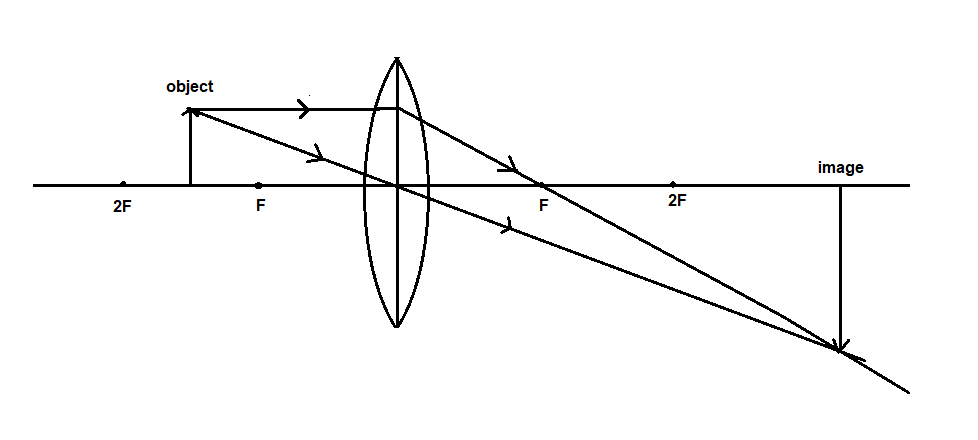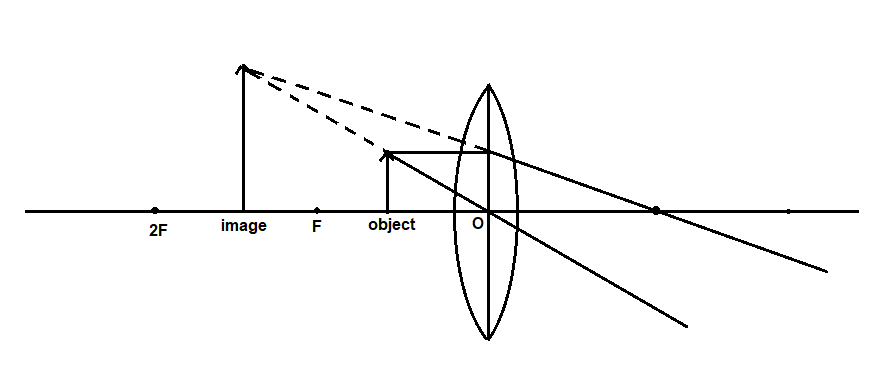
How can a converging lens produce a magnified image?
(A) When the object is beyond
(B) When the object is at
(C) When the object is at
(D) When the object is behind the mirror
Answer
143.1k+ views
Hint In a converging lens, all the rays that are parallel to the principal axis will converge to a fixed point on the principal axis. Such a lens is called a convex lens. Here, we have to find where we have to place the object to get a magnified image. We have to use a ray diagram to find the right answer.
Complete Step by step solution
In this case, the magnification of the image will happen when the object is placed between

The image will be formed on the opposite side of the lens and it will be located beyond
Here the correct options are not listed among the given options.
Additional Information
The location of the image is where the light rays are converging. If we place a screen at that point we will get the projection of the image on the screen. When the object is placed on the focus
Note
Alternate answer:
The image will be magnified when the object is placed between the focus

Complete Step by step solution
In this case, the magnification of the image will happen when the object is placed between

The image will be formed on the opposite side of the lens and it will be located beyond
Here the correct options are not listed among the given options.
Additional Information
The location of the image is where the light rays are converging. If we place a screen at that point we will get the projection of the image on the screen. When the object is placed on the focus
Note
Alternate answer:
The image will be magnified when the object is placed between the focus

Latest Vedantu courses for you
Grade 10 | MAHARASHTRABOARD | SCHOOL | English
Vedantu 10 Maharashtra Pro Lite (2025-26)
School Full course for MAHARASHTRABOARD students
₹33,300 per year
Recently Updated Pages
How to find Oxidation Number - Important Concepts for JEE

How Electromagnetic Waves are Formed - Important Concepts for JEE

Electrical Resistance - Important Concepts and Tips for JEE

Average Atomic Mass - Important Concepts and Tips for JEE

Chemical Equation - Important Concepts and Tips for JEE

Concept of CP and CV of Gas - Important Concepts and Tips for JEE

Trending doubts
JEE Main 2025 Session 2: Application Form (Out), Exam Dates (Released), Eligibility, & More

JEE Main Exam Marking Scheme: Detailed Breakdown of Marks and Negative Marking

JEE Main 2025: Derivation of Equation of Trajectory in Physics

Electric Field Due to Uniformly Charged Ring for JEE Main 2025 - Formula and Derivation

Electric field due to uniformly charged sphere class 12 physics JEE_Main

Degree of Dissociation and Its Formula With Solved Example for JEE

Other Pages
JEE Advanced Marks vs Ranks 2025: Understanding Category-wise Qualifying Marks and Previous Year Cut-offs

JEE Advanced 2025: Dates, Registration, Syllabus, Eligibility Criteria and More

JEE Advanced Weightage 2025 Chapter-Wise for Physics, Maths and Chemistry

Physics Average Value and RMS Value JEE Main 2025

Dual Nature of Radiation and Matter Class 12 Notes: CBSE Physics Chapter 11

Formula for number of images formed by two plane mirrors class 12 physics JEE_Main




